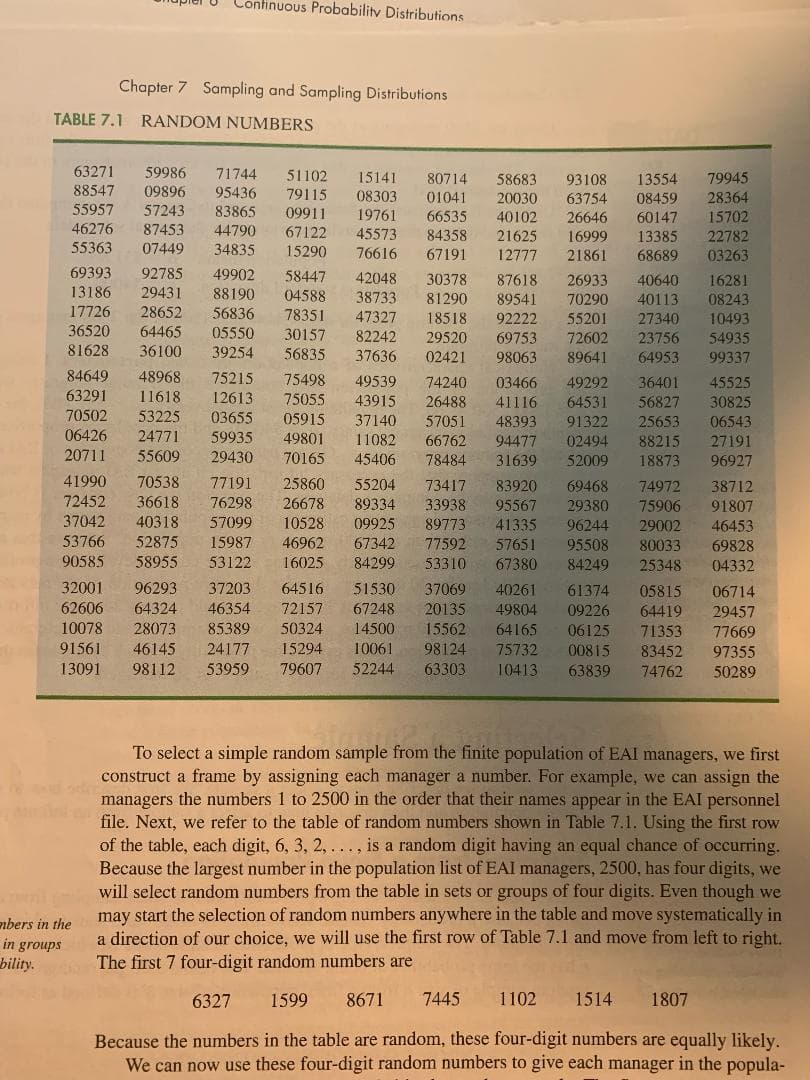USE THE TABLE 7.1, RANDOM NUMBERS, FROM YOUR TEXTBOOK (P. 308) Assume a finite population has 400 elements. Using the first three digits of column four (starting with 511, 791, 099, ...), determine the first eight elements that will be selected for the simple random sample.
USE THE TABLE 7.1, RANDOM NUMBERS, FROM YOUR TEXTBOOK (P. 308) Assume a finite population has 400 elements. Using the first three digits of column four (starting with 511, 791, 099, ...), determine the first eight elements that will be selected for the simple random sample.
Holt Mcdougal Larson Pre-algebra: Student Edition 2012
1st Edition
ISBN:9780547587776
Author:HOLT MCDOUGAL
Publisher:HOLT MCDOUGAL
Chapter11: Data Analysis And Probability
Section11.4: Collecting Data
Problem 2E
Related questions
Question
USE THE TABLE 7.1, RANDOM NUMBERS, FROM YOUR TEXTBOOK (P. 308)
Assume a finite population has 400 elements. Using the first three digits of column four (starting with 511, 791, 099, ...), determine the first eight elements that will be selected for the simple random sample.

Transcribed Image Text:Confinuous Probabilitv Distributions
Chapter 7 Sampling and Sampling Distributions
TABLE 7.1 RANDOM NUMBERS
63271
59986
71744
95436
51102
15141
79945
80714
01041
66535
58683
20030
93108
13554
88547
09896
79115
28364
15702
08303
63754
08459
55957
57243
83865
09911
19761
40102
26646
60147
46276
87453
44790
67122
45573
84358
21625
22782
16999
21861
13385
68689
55363
07449
34835
15290
76616
67191
12777
03263
69393
92785
49902
58447
42048
30378
87618
26933
40640
16281
13186
29431
88190
04588
38733
81290
89541
70290
40113
08243
17726
28652
56836
78351
47327
18518
92222
55201
27340
10493
36520
64465
05550
30157
82242
29520
72602
89641
69753
23756
54935
81628
36100
39254
56835
37636
02421
98063
64953
99337
84649
48968
75215
75498
49539
74240
03466
49292
36401
45525
63291
11618
12613
75055
64531
91322
43915
26488
41116
56827
30825
70502
53225
03655
05915
37140
57051
48393
25653
06543
06426
24771
59935
49801
11082
66762
94477
02494
88215
27191
20711
55609
29430
70165
45406
78484
31639
52009
18873
96927
41990
70538
77191
25860
55204
73417
83920
69468
74972
38712
72452
36618
76298
26678
89334
95567
41335
75906
29002
33938
29380
91807
37042
40318
57099
10528
09925
89773
96244
46453
53766
52875
15987
46962
67342
77592
57651
95508
80033
69828
90585
58955
53122
16025
84299
53310
67380
84249
25348
04332
32001
96293
37203
37069
20135
64516
51530
40261
61374
05815
06714
62606
64324
46354
72157
67248
49804
09226
64419
29457
10078
28073
85389
50324
14500
15562
64165
06125
71353
77669
91561
46145
24177
15294
10061
98124
75732
00815
83452
97355
13091
98112
53959
79607
52244
63303
10413
63839
74762
50289
To select a simple random sample from the finite population of EAI managers, we first
construct a frame by assigning each manager a number. For example, we can assign the
managers the numbers 1 to 2500 in the order that their names appear in the EAI personnel
file. Next, we refer to the table of random numbers shown in Table 7.1. Using the first row
of the table, each digit, 6, 3, 2, . .., is a random digit having an equal chance of occurring.
Because the largest number in the population list of EAI managers, 2500, has four digits, we
will select random numbers from the table in sets or groups of four digits. Even though we
may start the selection of random numbers anywhere in the table and move systematically in
a direction of our choice, we will use the first row of Table 7.1 and move from left to right.
The first 7 four-digit random numbers are
nbers in the
in groups
bility.
6327
1599
8671
7445
1102
1514
1807
Because the numbers in the table are random, these four-digit numbers are equally likely.
We can now use these four-digit random numbers to give each manager in the popula-
Expert Solution
This question has been solved!
Explore an expertly crafted, step-by-step solution for a thorough understanding of key concepts.
Step by step
Solved in 2 steps

Recommended textbooks for you

Holt Mcdougal Larson Pre-algebra: Student Edition…
Algebra
ISBN:
9780547587776
Author:
HOLT MCDOUGAL
Publisher:
HOLT MCDOUGAL


Holt Mcdougal Larson Pre-algebra: Student Edition…
Algebra
ISBN:
9780547587776
Author:
HOLT MCDOUGAL
Publisher:
HOLT MCDOUGAL
